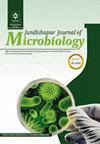TaqMan Multiplex Real-time PCR Assay for Crimean-Congo Hemorrhagic Fever Virus Diagnosis Using Armored RNA Technology
IF 0.5
4区 医学
Q4 MICROBIOLOGY
引用次数: 0
Abstract
Background: Crimean-Congo hemorrhagic fever virus (CCHFV) is a highly lethal virus that causes hemorrhagic fever in humans and is endemic in many countries, including Iran. Therefore, fast, accurate, and reliable diagnosis is crucial for patient management and outbreak control. Objectives: This study aims to optimize a TaqMan multiplex real-time RT-PCR for the rapid and specific diagnosis of CCHFV. Methods: In this study, the L (NC_005301.3) and S (NC_005302.1) fragments were used as reference sequences for blast analysis. The L and S sequence segments of CCHFV with more than 90% identity from different areas were downloaded from the Genbank database. Primers and probes were designed based on the best-conserved regions of CCHFV L and S sequence segments. To construct the plasmid, a 1751 bp fragment from the MS2 phage that was previously amplified using cloning primers was inserted into the pET-32a plasmid. The S and L segments of the CCHFV, which were 110 bp and 135 bp, respectively, were inserted downstream of the MS2 phage sequence from HindIII to NotI. The Viral-like particles (VLPs) were produced in Escherichia coli, strain BL-21(DE3), in the presence of 1 mM Isopropyl β-D-1-thiogalactopyranoside (IPTG). The stability of VLP particles was confirmed in the presence of the ribonuclease enzyme. The fabrication of VLPs was approved by transmission electron microscopy (TEM) with negative staining (1% phosphotungstic acid). To validate the specificity of the primers and probes sequences, we compared them to the NCBI database and tested them experimentally using extracted DNA and RNA samples from healthy subjects and an infectious panel. Results: The VLPs showed complete resistance in the presence of the ribonuclease enzyme, and the TEM results confirmed that the VLPs were correctly produced. The TaqMan multiplex real-time RT-PCR confirmed that the primers and probes were designed correctly and were completely specific to the CCHFV. The limit of detection (LOD) of the multiplex assay for the L and S genes was one copy of the VLPs per µL. Conclusions: This TaqMan assay is reliable for amplifying CCHFV due to its design on conserved regions of the CCHFV sequences, which have minimal variability and high specificity.TaqMan多重实时PCR技术在克里米亚-刚果出血热病毒诊断中的应用
背景:克里米亚-刚果出血热病毒(CCHFV)是一种导致人类出血热的高致死性病毒,在包括伊朗在内的许多国家流行。因此,快速、准确和可靠的诊断对患者管理和疫情控制至关重要。目的:本研究旨在优化TaqMan多重实时RT-PCR用于CCHFV的快速和特异性诊断。方法:在本研究中,使用L(NC_005301.3)和S(NC_00530 2.1)片段作为参考序列进行爆破分析。从Genbank数据库中下载了来自不同地区的具有90%以上同一性的CCHFV的L和S序列片段。引物和探针是基于CCHFV L和S序列片段的最佳保守区设计的。为了构建质粒,将先前使用克隆引物扩增的来自MS2噬菌体的1751bp片段插入pET-32a质粒中。CCHFV的S和L片段分别为110bp和135bp,插入从HindIII到NotI的MS2噬菌体序列的下游。在1mM异丙基β-D-1硫代吡喃半乳糖苷(IPTG)存在下,在大肠杆菌BL-21(DE3)菌株中产生病毒样颗粒(VLP)。VLP颗粒的稳定性在核糖核酸酶的存在下得到证实。VLP的制备通过透射电子显微镜(TEM)和阴性染色(1%磷钨酸)获得批准。为了验证引物和探针序列的特异性,我们将它们与NCBI数据库进行了比较,并使用从健康受试者和感染小组提取的DNA和RNA样本对它们进行了实验测试。结果:在核糖核酸酶存在下,VLP表现出完全的抗性,TEM结果证实VLP是正确产生的。TaqMan多重实时RT-PCR证实引物和探针设计正确,对CCHFV完全特异。L和S基因多重检测的检测限(LOD)为每µL一个VLP拷贝。结论:该TaqMan分析法是扩增CCHFV的可靠方法,因为它设计在CCHFV序列的保守区,具有最小的变异性和高特异性。
本文章由计算机程序翻译,如有差异,请以英文原文为准。
求助全文
约1分钟内获得全文
求助全文
来源期刊

Jundishapur Journal of Microbiology
MICROBIOLOGY-
CiteScore
1.30
自引率
0.00%
发文量
56
审稿时长
6-12 weeks
期刊介绍:
Jundishapur Journal of Microbiology, (JJM) is the official scientific Monthly publication of Ahvaz Jundishapur University of Medical Sciences. JJM is dedicated to the publication of manuscripts on topics concerning all aspects of microbiology. The topics include medical, veterinary and environmental microbiology, molecular investigations and infectious diseases. Aspects of immunology and epidemiology of infectious diseases are also considered.
 求助内容:
求助内容: 应助结果提醒方式:
应助结果提醒方式:


